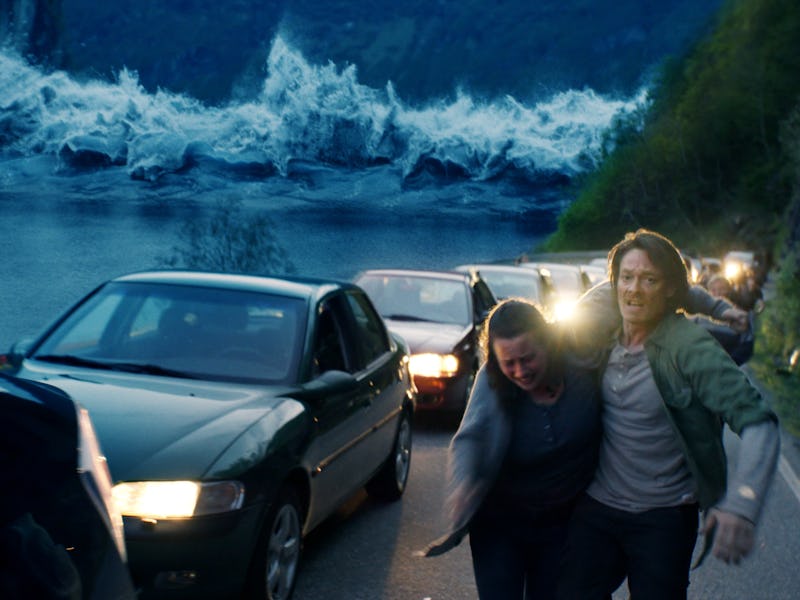'Tomb Raider' Director's Norwegian Disaster Film Hit Netflix
Roar Uthaug's directing the 'Tomb Raider' reboot. What does his work on 'The Wave' tell us about what he might bring to the newest Lara Croft interpretation?

Available today on Netflix, The Wave is Norwegian director (and director of 2018’s Tomb Raider film) Roar Uthaug’s take on blockbuster disaster films. Set in the small town of Geiranger, one of Norway’s most prominent tourist destinations, the film revolves around the threat of a rockslide from the unstable Åkerneset mountain that towers over the fjord.
The rockslide is something of an inevitability — not an “if,” but a “when.” And when it happens, it’s going to send seven million cubic meters of rock into the fjord below, creating a massive, 80m wave that will reach the small town of Geiranger 10 minutes later. Geologist Kristian (Kristoffer Joner) has been monitoring Åkerneset for years, but on his final day in Geiranger before moving to Stavanger to take a job with an oil company, the mountain begins to show signs of increasing instability. When it finally gives way, Kristian, his family, and the people of Geiranger will only have minutes to get to high ground.
Much of The Wave was filmed in the real town of Geiranger, which really is a thriving tourist destination and really does live under the threat of a rockslide. Though they moved off-site to film the big action sequences, The Wave takes full advantage of the stunning Norwegian landscape, making it one of the central characters in the film.
There’s a lot about The Wave that feels familiar and very much a part of the disaster film genre, but what stands out about it is the focus on character over big action sequences. The Wave isn’t packed to the gills with the massive sequences we’ve come to expect from films like San Andreas or The Day After Tomorrow. Instead, its attention is focused on its characters and on the devastation as it affects them and as they see it. Though sprawling scenes of destruction are something of a hallmark of the genre, The Wave is light on them in large part because the film’s budget was just $6 million (San Andreas had a budget of $110 million).
Budget limitations aside, though, Uthaug wanted to keep the film’s focus on the “human story.”
“[W]e wanted the movie to have a very intimate feel to it and feel that we’re in the middle of it with the characters and that it’s something that could happen, and will happen, for real,” Uthaug told IGN. “So I think that kind of implies both how we shaped the story and how we shot the movie… always staying close to the characters and not cutting away to like president speeches or that kind of stuff.”
The film doesn’t suffer for it. The decision to stay close to the characters gives the film an air of urgency and immediate danger, and the use of characters as a lens for the devastation is so effective that it makes us wish that disaster films weren’t so quick to beat us over the head with empty spectacle.
It turns out that trimming the spectacle fat left Uthaug with plenty of money to make a really beautiful film. As previously mentioned, it’s not difficult to make wide shots of Norway’s landscape look stunning, but scenes like the ones that take place in the deeply dangerous crevasse in Åkerneset are as aesthetically compelling as they are evocative. As Kristian makes his way through devastation by boat after the tsunami, there’s a gripping sense of devastation and unsettling stillness that doesn’t require big, mind-blowingly expensive shots of a completely leveled city.
Geiranger is a small town and while there are shots that show the destructive aftermath, they feel deeply personal. We’re not seeing the destroyed remains of skyscrapers and landmarks, but the hotel where Kristian’s wife, Idun, works, and the homes of his neighbors. It’s sobering and effective.
Uthaug’s next project is the Tomb Raider reboot, and his work on The Wave makes us very, very excited to see what he does with Lara Croft. His attention to and focus on character and The Wave’s demonstrated ability to make hallways, crevasses, boats, and buses feel beautiful, dangerous, horrifying, disquieting, and unnerving is something that could make Tomb Raider really great. Because as awesome as it is to see crumbling ruins and near-superheroic stunts, Tomb Raider’s defining factor will be the strength of Lara’s story and her character’s journey.
The way in which we see not only Geiranger and Geirangerfjord, but also our main characters transform throughout the course of The Wave speaks volumes about Uthaug’s approach, and it may be a big part of why he landed the Tomb Raider gig. When you’re bringing to life a character as important and iconic as Lara Croft, it’s vital that the film foregrounds the right things — not the mysterious and dramatic storms surrounding Yamatai or the breathtaking expanse of a subterranean city, but Lara herself. Sure, we expect Tomb Raider to be big and beautiful, but we’re there to follow a character, not witness a series of expensive set pieces. Uthaug seems to fundamentally understand the value of that distinction, and we can’t wait to see what he brings to Tomb Raider.